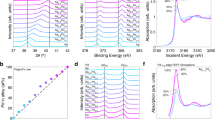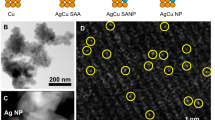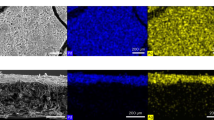Abstract
The electrochemical oxygen reduction reaction is the limiting half-reaction for low-temperature hydrogen fuel cells, and currently costly Pt-based electrocatalysts are used to generate adequate rates. Although most other metals are not stable in typical acid-mediated cells, alkaline environments permit the use of less costly electrodes, such as silver. Unfortunately, monometallic silver is not sufficiently active for economical fuel cells. Herein we demonstrate the design of low-cost Ag–Co surface alloy nanoparticle electrocatalysts for oxygen reduction. Their performance relative to that of Pt is potential dependent, but reaches over half the area-specific activity of Pt nanoparticle catalysts and is more than a fivefold improvement over pure silver nanoparticles at typical operating potentials. The Ag–Co electrocatalyst was initially identified with quantum chemical calculations and then synthesized using a novel technique that generates a surface alloy, despite bulk immiscibility of the constituent materials. Characterization studies support the hypothesis that the activity improvement comes from a ligand effect, in which cobalt atoms perturb surface silver sites.
This is a preview of subscription content, access via your institution
Access options
Subscribe to this journal
Receive 12 print issues and online access
$259.00 per year
only $21.58 per issue
Buy this article
- Purchase on Springer Link
- Instant access to full article PDF
Prices may be subject to local taxes which are calculated during checkout





Similar content being viewed by others

Change history
11 August 2014
Technical issues with our online publication processes resulted in this Article being published the day after that referred to in the print version. The official date of publication is 11 August 2014.
References
The US Department of Energy (DOE). Energy Efficiency and Renewable Energy; www1.eere.energy.gov/hydrogenandfuelcells/mypp/
Debe, M. K. Electrocatalyst approaches and challenges for automotive fuel cells. Nature 486, 43–51 (2012).
Borup, R. et al. Scientific aspects of polymer electrolyte fuel cell durability and degradation. Chem. Rev. 107, 3904–3951 (2007).
Gasteiger, H. A., Kocha, S. S., Sompalli, B. & Wagner, F. T. Activity benchmarks and requirements for Pt, Pt-alloy, and non-Pt oxygen reduction catalysts for PEMFCs. Appl. Catal. B 56, 9–35 (2005).
Wagner, F. T., Lakshmanan, B. & Mathias, M. F. Electrochemistry and the future of the automobile. J. Phys. Chem. Lett. 1, 2204–2219 (2010).
Pourbaix, M. Atlas of Electrochemical Equilibria in Aqueous Solutions (National Association of Corrosion Engineers, 1974).
Oezaslan, M., Hasché, F. & Strasser, P. Oxygen electroreduction on PtCo3, PtCo and Pt3Co alloy nanoparticles for alkaline and acidic PEM fuel cells. J. Electrochem. Soc. 159, B394–B405 (2012).
Subbaraman, R. et al. Origin of anomalous activities for electrocatalysts in alkaline electrolytes. J. Phys. Chem. C 116, 22231–22237 (2012).
US Geological Survey. Mineral Commodity Summaries 2010; http://minerals.usgs.gov/minerals/pubs/mcs/ (2010).
Spendelow, J. S. & Wieckowski, A. Electrocatalysis of oxygen reduction and small alcohol oxidation in alkaline media. Phys. Chem. Chem. Phys. 9, 2654–2675 (2007).
Blizanac, B. B., Ross, P. N. & Markovic, N. M. Oxygen reduction on silver low-index single-crystal surfaces in alkaline solution: rotating ring disk (Ag(hkl)) studies. J. Phys. Chem. B 110, 4735–4741 (2006).
Coutanceau, C., Demarconnay, L., Lamy, C. & Leger, J. M. Development of electrocatalysts for solid alkaline fuel cell (SAFC). J. Power Sources 156, 14–19 (2006).
Wiberg, G. K. H., Mayrhofer, K. J. J. & Arenz, M. Investigation of the oxygen reduction activity on silver – a rotating disc electrode study. Fuel Cells 10, 575–581 (2010).
Singh, P. & Buttry, D. A. Comparison of oxygen reduction reaction at silver nanoparticles and polycrystalline silver electrodes in alkaline solution. J. Phys. Chem. C 116, 10656–10663 (2012).
Varcoe, J. R. & Slade, R. C. T. Prospects for alkaline anion-exchange membranes in low temperature fuel cells. Fuel Cells 5, 187–200 (2005).
Varcoe, J. R., Slade, R. C. T., Wright, G. L. & Chen, Y. L. Steady-state dc and impedance investigations of H2/O2 alkaline membrane fuel cells with commercial Pt/C, Ag/C, and Au/C cathodes. J. Phys. Chem. B 110, 21041–21049 (2006).
Adams, L., Poynton, S. & Tamain, C. A carbon dioxide tolerant aqueous-electrolyte-free anion-exchange membrane alkaline fuel cell. ChemSusChem 1, 79–81 (2008).
Strmcnik, D. et al. Improving the hydrogen oxidation reaction rate by promotion of hydroxyl adsorption. Nature Chem. 5, 300–306 (2013).
Blizanac, B. B., Ross, P. N. & Markovic, N. M. Oxygen electroreduction on Ag(111): the pH effect. Electrochim. Acta 52, 2264–2271 (2007).
Stamenkovic, V. R. et al. Improved oxygen reduction activity on Pt3Ni(111) via increased surface site availability. Science 315, 493–497 (2007).
Stephens, I. E. L., Bondarenko, A. S., Grønbjerg, U., Rossmeisl, J. & Chorkendorff, I. Understanding the electrocatalysis of oxygen reduction on platinum and its alloys. Energy Environ. Sci. 5, 6744–6762 (2012).
Holewinski, A. & Linic, S. Elementary mechanisms in electrocatalysis: revisiting the ORR Tafel slope. J. Electrochem. Soc. 159, H864–H870 (2012).
Markovic, N. M. & Ross, P. N. Surface science studies of model fuel cell electrocatalysts. Surf. Sci. Rep. 45, 117–229 (2002).
Tripković, V., Skúlason, E., Siahrostamia, S., Nørskov, J. K. & Rossmeisl, J. The oxygen reduction reaction mechanism on Pt(111) from density functional theory calculations. Electrochim. Acta 55, 7975–7981 (2010).
Savinova, E. R. et al. Structure and dynamics of the interface between a Ag single crystal electrode and an aqueous electrolyte. Discuss. Faraday Soc. 121, 181–198 (2002).
Horswell, S. L. et al. A comparative study of hydroxide adsorption on the (111), (110), and (100) faces of silver with cyclic voltammetry, ex situ electron diffraction, and in situ second harmonic generation. Langmuir 20, 10970–10981 (2004).
Hansen, H. A., Rossmeisl, J. & Norskov, J. K. Surface Pourbaix diagrams and oxygen reduction activity of Pt, Ag and Ni(111) surfaces studied by DFT. Phys. Chem. Chem. Phys. 10, 3722–3730 (2008).
Nørskov, J. K. et al. Origin of the overpotential for oxygen reduction at a fuel-cell cathode. J. Phys. Chem. B 108, 17886–17892 (2004).
Xin, H. L. & Linic, S. Communications: exceptions to the d-band model of chemisorption on metal surfaces: the dominant role of repulsion between adsorbate states and metal d-states. J. Chem. Phys. 132, 221101 (2010).
Xin, H., Holewinski, A. & Linic, S. Predictive structure–reactivity models for rapid screening of Pt-based multimetallic electrocatalysts for the oxygen reduction reaction. ACS Catalysis 2, 12–16 (2012).
Zhang, Z. Y., Nenoff, T. M., Huang, J. Y., Berry, D. T. & Provencio, P. P. Room temperature synthesis of thermally immiscible Ag-Ni nanoalloys. J. Phys. Chem. C 113, 1155–1159 (2009).
Wang, D. & Li, Y. Bimetallic nanocrystals: liquid-phase synthesis and catalytic applications. Adv. Mater. 23, 1044–1060 (2011).
Gong, K., Su, D. & Adzic, R. R. Platinum-monolayer shell on AuNi0.5Fe nanoparticle core electrocatalyst with high activity and stability for the oxygen reduction reaction. J. Am. Chem. Soc. 132, 14364–14366 (2010).
Goodwin, A. L. et al. Colossal positive and negative thermal expansion in the framework material Ag3[Co(CN)6]. Science 319, 794–797 (2008).
Ludi, A., Gudel, H. U. & Dvorak, V. The structure of H3Co(CN)6 and Ag3Co(CN)6 . Helv. Chim. Acta 7, 2035–2039 (1967).
Fernandez, J., Walsh, D. & Bard, A. Thermodynamic guidelines for the design of bimetallic catalysts for oxygen electroreduction and rapid screening by scanning electrochemical microscopy. M–Co (M: Pd, Ag, Au). J. Am. Chem. Soc. 357–365 (2005).
Lima, F. H. B., de Castro, J. F. R. & Ticianelli, E. A. Silver–cobalt bimetallic particles for oxygen reduction in alkaline media. J. Power Sources 161, 806–812 (2006).
Loglio, F. et al. Cobalt monolayer islands on Ag(111) for ORR catalysis. ChemSusChem 4, 1112–7 (2011).
Schmidt, T. J. et al. Characterization of high-surface area electrocatalysts using a rotating disk electrode configuration. J. Electrochem. Soc. 145, 2354–2358 (1998).
Kirowa-Eisner, E., Bonfil, Y., Tzur, D. & Gileadi, E. Thermodynamics and kinetics of upd of lead on polycrystalline silver and gold. J. Electroanal. Chem. 552, 171–183 (2003).
Herrero, E., Buller, L. J. & Abruna, H. D. Underpotential deposition at single crystal surfaces of Au, Pt, Ag and other materials. Chem. Rev. 101, 1897–1930 (2001).
Zhang, J., Sasaki, K., Sutter, E. & Adzic, R. R. Stabilization of platinum oxygen-reduction electrocatalysts using gold clusters. Science 315, 220–222 (2007).
Koenigsmann, C. et al. Enhanced electrocatalytic performance of processed, ultrathin, supported Pd–Pt core–shell nanowire catalysts for the oxygen reduction reaction. J. Am. Chem. Soc. 133, 9783–9795 (2011).
Wang, C. et al. Multimetallic Au/FePt3 nanoparticles as highly durable electrocatalyst. Nano Lett. 11, 919–926 (2011).
Bratsch, S. Standard electrode potentials and temperature coefficients in water at 298.15K. J. Phys. Chem. Ref. Data 18, 1–21 (1989).
Gerken, J. B. et al. Electrochemical water oxidation with cobalt-based electrocatalysts from pH 0–14: the thermodynamic basis for catalyst structure, stability, and activity. J. Am. Chem. Soc. 133, 14431–14442 (2011).
Krivanek, O. L. et al. An electron microscope for the aberration-corrected era. Ultramicroscopy 108, 179–195 (2008).
Greeley, J. et al. Alloys of platinum and early transition metals as oxygen reduction electrocatalysts. Nature Chem. 1, 552–556 (2009).
Viswanathan, V., Hansen, H. A., Rossmeisl, J. & Nørskov, J. K. Universality in oxygen reduction electrocatalysis on metal surfaces. ACS Catalysis 2, 1654–1660 (2012).
Acknowledgements
We acknowledge support from the US DOE Office of Basic Energy Sciences, Division of Chemical Sciences (FG-02-05ER15686). We also acknowledge the University of Michigan Electron Microbeam Analysis Laboratory for use of the microscopy facilities. This research is also supported as part of a user project by Oak Ridge National Laboratory (ORNL)'s Center for Nanophase Materials Sciences, which is sponsored by the Scientific User Facilities Division, Office of Basic Energy Sciences, US DOE (J-C.I.). Finally, we acknowledge H. Xin and T. van Cleve for helpful discussions and experimental assistance.
Author information
Authors and Affiliations
Contributions
A.H. and S.L. devised and developed the project. A.H. carried out experimental work, theoretical calculations and data analysis. J-C.I. performed STEM and EELS imaging at ORNL. All the authors wrote the manuscript.
Corresponding author
Ethics declarations
Competing interests
The authors declare no competing financial interests.
Supplementary information
Supplementary information
Supplementary information (PDF 5288 kb)
Rights and permissions
About this article
Cite this article
Holewinski, A., Idrobo, JC. & Linic, S. High-performance Ag–Co alloy catalysts for electrochemical oxygen reduction. Nature Chem 6, 828–834 (2014). https://doi.org/10.1038/nchem.2032
Received:
Accepted:
Published:
Issue Date:
DOI: https://doi.org/10.1038/nchem.2032
This article is cited by
-
Tuning the apparent hydrogen binding energy to achieve high-performance Ni-based hydrogen oxidation reaction catalyst
Nature Communications (2024)
-
Investigation of oxygen reduction reaction activity on Pt-Fe/C catalyst
Ionics (2023)
-
Ag and Au nanoparticles decorated on synthetic clay functionalized multi-walled carbon nanotube for oxygen reduction reaction
Applied Nanoscience (2023)
-
Regulating the scaling relationship for high catalytic kinetics and selectivity of the oxygen reduction reaction
Nature Communications (2022)
-
Silver based single atom catalyst with heteroatom coordination environment as high performance oxygen reduction reaction catalyst
Nano Research (2022)


